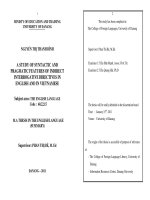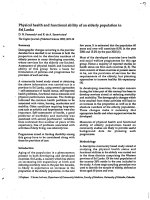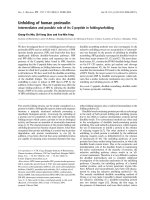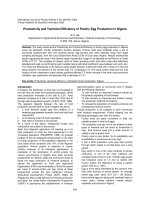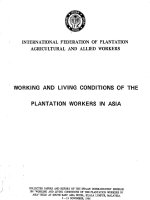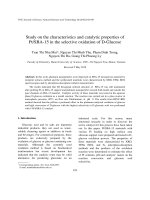Testing, assessment and FRP strengthening of concrete T-beam bridges in Pennsylvania
Bạn đang xem bản rút gọn của tài liệu. Xem và tải ngay bản đầy đủ của tài liệu tại đây (4.44 MB, 186 trang )
TESTING, ASSESSMENT AND FRP STRENGTHENING
OF CONCRETE T-BEAM BRIDGES IN PENNSYLVANIA
William C. Sasher
Thesis submitted to the
College of Engineering and Mineral Resources
at
West Virginia University
in partial fulfillment of the requirements
for the degree of
Master of Science
in
Civil and Environmental Engineering
Karl E. Barth, Ph. D., Chair
Julio F. Davalos, Ph. D., Co-Chair
Indrajit Ray, Ph. D.
Department of Civil and Environmental Engineering
Morgantown, West Virginia
2008
Keywords: fiber reinforced polymer (FRP), concrete t-beam bridge, load testing, load
rating, FRP strengthening
UMI Number: 1458524
INFORMATION TO USERS
The quality of this reproduction is dependent upon the quality of the copy
submitted. Broken or indistinct print, colored or poor quality illustrations and
photographs, print bleed-through, substandard margins, and improper
alignment can adversely affect reproduction.
In the unlikely event that the author did not send a complete manuscript
and there are missing pages, these will be noted. Also, if unauthorized
copyright material had to be removed, a note will indicate the deletion.
®
UMI
UMI Microform 1458524
Copyright 2008 by ProQuest LLC.
All rights reserved. This microform edition is protected against
unauthorized copying under Title 17, United States Code.
ProQuest LLC
789 E. Eisenhower Parkway
PO Box 1346
Ann Arbor, Ml 48106-1346
TESTING, ASSESSMENT AND F R P STRENGTHENING OF
CONCRETE T-BEAM BRIDGES TN PENNSYLVANIA
William Christopher Sasher
Dr. Karl E. Barth. Thesis Advisor
Abstract
The transportation infrastructure of the United States is in urgent need of
rehabilitation. The effects of ageing and deterioration, along with increased traffic
demands have raised the concern that the deteriorated conditions of highway bridges need
to be addressed to insure the safety of the public. Several rehabilitation methods are
available to engineers including: bridge replacement, bridge repair, and retrofitting with
mechanisms designed to increase the structural capacity of a bridge.
The Pennsylvania Department of Transportation - District 3 (PennDOT-D3) has
sponsored a multi-phase project to investigate externally bonded Fiber Reinforced
Polymer (FRP) technology on their deteriorated concrete T-Beam bridges. The bridge
inventory maintained by PennDOT-D3 includes 128 concrete T-Beam bridges built
between 1920 and 1960. Ageing and deterioration effects have caused these bridges to
become structurally deficient and/or obsolete. PennDOT-D3 has teamed with researchers
from West Virginia University to develop a system to transfer FRP bridge rehabilitation
technology to PennDOT's district forces.
The work presented in this thesis focuses on the structural condition assessment
and strengthening with externally bonded FRP of bridge #49-4012-0250-1032 built in
1934 near Sunbury, Pennsylvania. During several field visits. WVU researchers
performed destructive and non-destructive testing to investigate the deteriorated
condition of the bridge. Load testing was performed using a proof load to attain critical
structural behavior characteristic data that could be used to calibrate a computer model of
the bridge as well as to determine a bridge performance baseline to compare with the
FRP strengthened structural behavior.
During the course of work in this study, a structural analysis program was
developed to accurately assess the structural capacity of a simply supported concrete TBeam bridge. The program was designed to be more flexible and easier to use than
PennDOT's Bridge Analysis and Rating program (BAR7). The program developed at
WVU includes a section for FRP strengthening design. Load rating analysis based on the
strengthening design is included in the program.
ACKNOWLEDGEMENTS
The author would like to thank West Virginia University for the endless
opportunities that were made available. The classes, professors, student life, and
environment created at the university have all provided the author with an unforgettable
undergraduate and graduate career. Special thanks go to the civil engineering faculty
members at the College of Civil and Environmental Engineering. The attention to detail
necessitated by Dr. Zaniewski, Dr. Barth, and Dr. Davalos will always be one of the
greatest intangible lessons learned and continually pursued by the author.
The author would like to give particular gratitude to Dr. Barth for his neverending patience and guidance. Dr. Barth was also the one who generously gave the
author many of the opportunities that he has been privileged to be a part of throughout his
educational career at WVU. The lessons taught by Dr. Barth will never be forgotten.
The author would like to thank Dr. Davalos for die energy and excitement that he
exudes as a professor. It has been a privilege and a pleasure to the author to learn from
Dr. Davalos. He has been a great professor, advisor, and mentor.
The author would also like to thank his graduate student colleagues for the fun
times and the help and support given over the years.
The author would also like to thank his parents for their never-ending guidance,
support, and sacrifice. Their encouragement and advice has been invaluable to the
author. Words will never make up for the sacrifices that they have made. Remember:
"Superhuman effort isn't worth a damn unless it achieves results."-Ernest Shackleton.
- in
Table of Contents
ACKNOWLEI>KGMENTS.M--mMM.MM«M«.MM—•—•—»•*•
TABLE OF CONTENTS
.
..•„..•.
•.*.,..„,..........„..*...«..«...
*.•.•—.•—«•••—•«..•——
.—•.•,•..••..«„„ iii
*••.—*••••
—«.iv
X>IST O F F I G U R E S ••••••.••••••••••••••••••••••••••••••••^••^•.•.•.•••••••••••••••••••••••••••••••••••••••^•••""•••••••••••••••••••^••^•••••***"""*'
L I S T O F T A B L E S •••••••^•*#*#*»*«««».»*».»«»»».»*»...«.««*****»* M »»»»*«M*.**»*«««»***»«*»»»»»»*""«-*«*^*»*«»»»»""»»»«««««***»^^***""*» VI I I
CHAPTER 1 - INTRODUCTION
1.1
1.2
1.3
1.4
PROJECT BACKGROUND
BRIDGE DESCRIPTION
OBJECTIVES
SCOPE OF RESEARCH
1.4. i
1.4.2
] .4.3
1.4.4
1.5
l .6
1
2
4
4
Destructive and Non-Destructive Evaluation
Load Testing
Structural Analysis
FRP Strengthening Design Recommendations
4
5
6
6
ORGANIZATION
EXPECTED OUTCOMES
1.6.1
1.6.2
1.6.3
7
7
Load Rating
FRP Strengthening Design
Training PennDOT Personnel
S
S
8
CHAPTER 2 - LITERATURE REVIEW
2.1
2.2
2.3
INTRODUCTION
TRANSPORTATION INFRASTRUCTURE CONDITION ASSESSMENT.
LOAD RATING
2.3.1
2.3.2
2.3.3
2.4
2.5
2.6
10
10
12
Current Load Rating Methods
Load Rating Programs
Capacity Calculation Methods
14
17
'9
REHABILITATION STRATEGIES
FRP CONSTRUCTION AND DESIGN SPECIFICATIONS
CASE STUDIES
21
24
26
CHAPTER 3 - EXPERIMENTAL WORK
3.1
3.2
3.2.1
3.2.2
3.2.3
3.2.4
3.4
INTRODUCTION
BRIDGE MATERIAL ASSESSMENT SUMMARY
34
34
Concrete Core Sampling
Sampling of Tensile Reinforcing Steel
Visual Inspection and Documentation
Material Property Summary
34
36
38
42
LOAD TESTING
3.4.1
3.4.2
3.4.3
3.4.4
3.4.5
•
43
Setup
Trucks
Static Loading
Dynamic Loading
Testing Results
44
51
52
57
57
- iv-
CHAPTER 4 - STRUCTURAL CONDITION ASSESSMENT AND FRP STRENGTHENING
DESIGN
4.1
4.2
INTRODUCTION
LOAD RATING
4.3.1
BRIDGE PROPERTIES
4.3.2
LOAD RATING RESULTS
4.4
PROPOSED FRP STRENGTHENING SYSTEM
4.4.1
4.4.2
63
63
64
65
69
Assumptions
Beam Strengthening Design
70
71
CHAPTER 5 - DEVELOPMENT OF IMPROVED CONCRETE T-BEAM RATING PROCEDURES
5.1
5.2
INTRODUCTION
ANALYSIS VARIATIONS AND LIMITATIONS
79
81
5.2.1
Input Data
5.2.2
Analysis Calculations
5.2.3
Program Output
5.2.4
FRP Strengthening Design
5.3
ANALYSIS
5.3.1
Program Input
5.3.2
Program Analysis Calculations
5.3.3
Program Output
5.4
8i
82
82
83
84
84
95
107
FRP STRENGTHENING DESIGN
5.4.1
5.4.2
5.4.3
110
Program Input
,
Program Design Calculations
Program Output
112
117
i 19
CHAPTER 6 - CONCLUSIONS
6.1
6.2
6.3
6.4
INTRODUCTION
LOAD RATING COMPARISON
RECOMMENDATIONS
FUTURE WORK
122
123
124
125
REFERENCES....
~
-—..-
130
APPENDIX A: P E N N D O T 45 FT SPAN CONCRETE T-BEAM BRIDGE SHOP DRAWINGS
APPENDIX B: MATERIAL EVALUATION T E S T RESULTS...
APPENDIX
.~
C: STRUCTURAL ANALYSIS CALCULATIONS .—..—.
APPENDIX
F: FRP DESIGN CALCULATIONS
.....^.
—..
—
APPENDIX D: STRUCTURAL ANALYSIS CALCULATION RESULTS
APPENDIX E: DEAD/LIVE LOAD GENERATOR EQUATIONS
140
.— 143
..
«,
150
. —
155
.
160
APPENDIX G: FRP DESIGN CALCULATION VARIABLE RESULTS
APPENDIX H: PROPOSED FRP STRENGTHENING DESIGN DRAWINGS...
-v-
137
.~—
~...~
168
-
171
LIST OF FIGURES
FIGURE 1.1 SELECTED CANDIDATE BRIDGE REINFORCEMENT LAYOUT- ELEVATION VIEW
FIGURE 1.2 SELECTED CANDIDATE BRIDGE REINFORCEMENT LAYOUT- CROSS SECTION VIEW
FIGURE 1.3 SELECTEDCANDIDATEBRIDGEFOR LEVEL I FRPCOMIOSITE REPAIR
FIGURE 3.1 DECK CORE SAMPLING LOCATIONS
FIGURE 3.2 DECK CORE SAMPLE
FIGURE 3.3 DECK CORE DRILLING
FIGURE 3.4 EXPOSED REIJAR EXTRACTION TOOLS
FIGURE 3.5 LOCATION OF EXPOSED RF.UAR EXTRACTION
FIGURE 3.6 BEAM I - SPALLING, DELAMINATION, AND CRACKING.......
FIGURE 3.7 BEAM 6 - SPALLING, DELAMINATION. AND CRACKING
FIGURE 3.8 BEAM 2 - LOCALIZED DAMAGE
FIGURE 3.9 BEAM 5 LOCALIZED SPALLING AND DELAMINATION
FIGURE 3.10 BEAM 3 - MINOR DAMAGE
FIGURE 3.11 BEAM 4 - LOCALIZED DAMAGE
FIGURE 3.12 PLAN VIEW OF INSTRUMENTATION LAYOUT
FIGURE 3.13 FIELD PLACEMENTS OF EQUIPMENT AND INSTRUMENTS
FIGURE 3.14 ORIGINALLY PROPOSED STRAIN GAGE LOCATIONS
FIGURE 3.15 EPOXYCURETIME CHART
FIGURE 3.16 CROSS-SECTION VIEW OF INSTRUMENTATION SETUP
FIGURE 3.17 LVDT SETUP
FIGURE 3.18 LVDT BRACING
FIGURE 3.19 ACCELEROMETER MOUNTING CONFIGURATION
FIGURE 3.20 COMPUTER AND DATA ACQUISITION SETUP
3
3
3
35
36
36
37
37
39
39
40
40
41
41
44
45
46
46
47
FIGURE3.21 TRUCK LOADING
51
FIGURE 3.22 INITIAL LOAD CASES 1 AND 2
FIGURE 3.23 INITIAL LOAD CASES 3 AND 4
FIGURE 3.24 ACTUAL LOAD CASES USED
FIGURE 3.25 TRUCK SPACING LIMITATIONS
FIGURE 3.26 MODIFIED LOAD CASES
FIGURE 3.27 MODIFIED LOAD CASE TRUCK POSITION
FIGURE3.2S LOAD CASE 1 DEFLECTION RESULTS
FIGURE 3.29 LOAD CASE 2-1 TRUCK DEFLECTION RESULTS
FIGURE 3.30 LOAD CASE 2-2 TRUCKS DEFLECTION RESULTS
FIGURE 3.31 LOAD CASE 4 DEFLECTION RESULTS
FIGURE 3.32 MODIFIED LOAD CASE DEFLECTION COMPARISON
FIGURE 3.33 NATURAL FREQUENCY RESULTS
FIGURE4.1 EXAMPLE BRIDGE SECTIONING
FIGURE4.2 SHEAR INVENTORY RATING FACTOR RESULTS
FIGURE 4.3 BEAM 1 FRP STRENGTHENING DESIGN
FIGURE 4.4 BEAM 2 FRP STRENGTHENING DESIGN
FIGURE 4.5 BEAM 3 FRP STRENGTHENING DESIGN
FIGURE4.6 BEAM 4 FRP STRENGTHENING DESIGN
FIGURE 4.7 BEAM 5 FRP STRENGTHENING DESIGN
FIGURE 4.8 BEAM 6 FRP STRENGTHENING DESIGN
FIGURE 4.9 FRP STRENGTHENED LOAD RATING RESULTS
FIGURE4.10 PRE-AND POST- SHEAR STRENGTHENING INVENTORY RATING FACTOR COMPARISON
FIGURE 5.1 w v u PROGRAM PROCESS CHART
FIGURE 5.2 INPUT DATA SEQUENCE
FIGURE 5.3 SAMPLE SHEAR REMAINING STEEL REINFORCEMENT AREA INPUT DATA TABLES
FIGURE 5.4 CONCRETE T-BEAM ANALYSIS CALCULATION SEQUENCE
FIGURE 5.6 SAMPLE LIVE LOAD GENERATOR RESULTS TABLE
53
54
55
55
56
56
58
58
59
59
61
62
67
68
71
72
72
72
72
73
74
78
80
85
92
96
107
- vi -
48
48
49
50
FIGURE 5.7 LOAD RATING ANALYSIS CALCULATION SEQUENCE
108
FIGURE 5.8 SAMPLE RATING FACTOR SUMMARY CHART
109
FIGURE 5.9 FRP DESIGN CALCULATION SEQUENCE
111
FIGURES. 10 SAMPLE FLEXURAL FRPTERMINATION POINT CALCULATION GRAPH
115
FIGURE 5.11 SAMPLE SHEAR CAPACITY STRENGTHENING ANALYSIS RESULTS GRAPH
117
FIGURE 5.12 SAMPLE STRENGTHENED BEAM STRAIN DISTRIBUTION GRAPH
120
FIGURE5.13 SAMPLE EXISTING VS. STRENGTHENED BEAM FLEXURALLOAD RATING SUMMARY GRAPH. 120
FIGURE 5.14 SAMPLE BEAM EXISTING VS. STRENGTHENED LOAD RATING SUMMARY GRAPH
121
FIGURE E.1 LOADING VEHICLE CALCULATION DIAGRAM
157
FIGURE E.2 SHEAR FORCE DESIGNATION
158
FIGURE F.l SIDE FLEXURAL FRP LAMINATE CONTRIHUTION DIAGRAM
166
- vii -
LIST OF TABLES
TABLE 2.1 DESIGN EQUATION COMPARISON
TABLE 2.2 LOAD RATING EQUATION COMPARISON
TABLE 3.1 TRUCK LOADING COMPARISON: HS-20 VS. PENNDOT
TABLE4.1 LOAD RATING RESULTS- MOMENT
TABLE4.2 LOAD RATING RESULTS- SHEAR
TABLE 4.3 DESIGN REQUIREMENT DIFFERENCES
TABLE4.4 FRP MATERIAL PROPERTIES
TABLE 4.5 FLEXURAL FRP'STRENGTHENING RESULTS
TABLE4.6 BEAM I FRP SHEAR REINFORCEMENT DESIGN RESULTS
TABLE 4.7 BEAM 2 FRP SHEAR REINFORCEMENT DESIGN RESULTS
TABLE 4.8 BEAM 3 FRP SHEAR REINFORCEMENT DESIGN RESULTS
TABLE4.9 BEAM 4 FRP SHEAR REINFORCEMENT DESIGN RESULTS
TABLE4.10 BEAM 5 FRP SHEAR REINFORCEMENT DESIGN RESULTS
TABLE 4.11 BEAM 6 FRP SHEAR REINFORCEMENT DESIGN RESULTS
TABLE 5.1 SAMPLE UNIVERSAL INPUT DATA TABLE
TABLE 5.2 SAMPLE BEAM SPECIFIC FLEXURAL INPUT DATA TABLE
TABLE 5.3 SAMPLE BEAM SPECIFIC SHEAR SECTION BREAK INPUT DATA TABLE
TABLE 5.4 SAMPLE BEAM SPECIFIC SHEAR INVESTIGATION POINT TABLE
TABLE 5.5 SAMPLE INCLINED STIRRUP INCLUSION BY SECTION INPUT DATA TABLE
TABLE 5.6 SAMPLE PRESENCE OF SEVERE DIAGONAL CRACKING BY SECTION INPUT TABLE
TABLE 5.7 SAMPLE LOADING VEHICLE INPUT DATA TABLE
TABLE 5.8 SAMPLE SPECIAL LOADING VEHICLE INPUT DATA TABLE
TABLE 5.9 SAMPLE UNIVERSAL VARIABLE ANALYSIS RESULTS
TABLE 5.10 SAMPLE BEAM SPECIFIC FLEXURAL ANALYSIS RESULTS
TABLE 5.11 SAMPLE LIVE LOAD GENERATOR RESULTS TABLE
TABLE 5.12 SAMPLE TENTH POINT FLEXURAL LOAD RATING CALCULATION TABLE
TABLE 5.13 SAMPLE SHEAR ANALYSIS RESULTS TABLE
TABLE 5.14 SAMPLE SECTION SHEAR CAPACITY RESULTS TABLE
TABLE 5.15 SAMPLE TENTH POINTSHEAR CAPACITY RESULTSTABLE
TABLE 5.16 SAMPLE DEAD LOAD SHEAR RESULTS TABLE
TABLE 5.17 SAMPLE SHEAR LOAD RATING CALCULATION TABLE
TABLE 5.18 SAMPLE BEAM LOAD RATING SUMMARY TABLE
TABLE 5.19 SAMPLE CONTROLLING LOAD RATING TENTH POINT SUMMARY TABLE
TABLE5.20 SAMPLE CONTROLLING LOAD RATING FACTOR SUMMARY TABLES
TABLE 5.21 SAMPLE FRP MANUFACTURER'S REPORTED SYSTEM PROPERTIES TABLE
TABLE 5.22 SAMPLE FRP FLEXURAL STRENGTHENING INPUT/RESULTS TABLE
TABLE 5.23 SAMPLE SHEAR STRENGTHENING DESIGN TABLE
TABLE B.l CONCRETE COMPRESSION TEST RESULTS
TABLEB.2 ULTRA SONIC PULS* VELOCITY TEST VALUES
TABLE B.3 REBOUND HAMMER TEST VALUES
TABLE B.4 STEEL TENSION TEST SAMPLE-AREA CALCULATION
TABLE D. 1 UNIVERSAL STRUCTURAL ANALYSIS INPUT DATA VARIABLES
TABLE D.2 BEAM SPECIFIC INPUT DATA VARIABLES
TABLE D.3 MOMENT CAPACITY CALCULATION VARIABLE RESULTS
TABLE D.4 SHEAR CAPACITY CALCULATION VARIABLE RESULTS
TABLE E. 1 DEAD/LIVE LOAD CALCUI-ATION VARIABLE RESULTS
TABLE G.I MANUFACTURER'S REPORTED FRP SYSTEM PROPERTIES
TABLE G.2 FLEXURAL FRP DESIGN VARIABLE SUMMARY
TABLE G.3 FRP SHEAR DESIGN VARIABLES-BEAMS 1 AND 6
TABLE G.4 FRP SHEAR DESIGN VARIABLES- BEAMS 3 AND 4
TABLE G.5 FRP SHEAR DESIGN VARIABLES- BEAMS 2 AND 5
- viii -
15
16
52
66
68
69
73
74
76
77
77
77
78
78
87
88
90
90
91
92
94
95
97
99
100
101
102
103
104
104
105
108
109
110
112
113
116
141
14!
141
142
151
152
153
154
159
169
169
170
170
170
CHAPTER 1 - INTRODUCTION
1.1
PROJECT BACKGROUND
The Pennsylvania Department of Transportation - District 3 (PennDOT-D3) has
initiated a program to address the current condition of their concrete T-Beam bridges.
The district's bridge inventory includes 128 concrete T-Beam bridges built between 1920
and 1960. Deterioration and changing design standards call fc" *hese bridges to be
updated to conform to current roadway and bridge design sp*-
cations.
PennDOT - D3 has developed a plan to deal with the pre: •krms posed by these
deteriorated concrete T-Beam bridges. The plan involves the use of fiber-reinforced
polymers (FRP) to strengthen deteriorated bridges in order to improve the load capacity
and remove load restrictions on the bridge in a cost effective manner. The project has
been conducted in three phases.
Phase-I has been completed and involved examining the technical and economic
feasibility of the different options available and developing a selection process for each
bridge rehabilitation option. The selection process developed in Phase-I involved
categorizing concrete T-Beam bridges into one of three levels based on several factors.
The factors considered when ranking the bridges include: age, span length, average daily
traffic and average daily truck traffic (ADT/ADTT), and localized damage based on
visual inspection (Brayack, 2005).
Phase-II involves performing a bridge condition assessment and preliminary FRP
strengthening design. This phase required load testing before strengthening to compare
- 1-
the pre- and post-retro fitting effects. This thesis focuses on the tasks and results of
Phase-H activities. Phase-ILI activities will include the implementation of the FRP
strengthening design along with long term testing of the bridge both in the field and in lab
scale studies.
The ultimate goal of this project is for PennDOT - D3 to implement a
rehabilitation program that will enable district forces to independently identify, analyze,
and rehabilitate concrete T-Beam bridges in a cost effective manner using FRP
strengthening systems. Depending on the level of repair required, PennDOT will either:
contract out all of the work, use a combined approach of an outside contractor and district
forces; or al! work will be performed by district forces.
1.2
BRIDGE DESCRIPTION
The bridge selected to exercise this technology was built in 1934 and is near
Sunbury, Pennsylvania (PennDOT Bridge #49-4012-0250-1032). The simply supported
concrete T-Beam bridge spans 48 ft over a small creek and carries two traffic lanes on
Creek Road. The deck width is 26 ft-11 in. Six beams make up the superstructure with
an 8.5 in concrete deck and 2.5 in asphalt overlay. The beam reinforcement layout is
shown in Figures 1.1 and 1.2. The bridge can be assumed as a simply supported span of
45 feet from the inside face of the abutments for analysis purposes. Figure 1.3 shows the
extensive damage due to deterioration and corrosion.
-2-
:
Onlv
Figure 1.1 Selected Candidate Bridge Reinforcement Layout- Elevation A 'iw
Exterior
Interior
Figure 1.2 Selected Candidate Bridge Reinforcement Layout- Cross Section View
Figure 13 Selected Candidate Bridge for Level 1 FRP Composite Repair
-3-
13
OBJECTIVES
This thesis focuses on the field testing and structural analysis of a selected TBeam bridge prior to rehabilitation and preliminary FRP strengthening designs. The
objective of the field testing was to determine the current stale of deterioration and its
effects throughout the selected bridge. The structural analysis was required to determine
the existing load capacity and the additional required resistance that would need to be
provided by the FRP reinforcement.
A computer program was developed to facilitate structural analysis calculations
and comparisons. The program incorporates many of the analysis and design related
issues involved with this type of project. The computer program could be used as an
analysis tool to analyze, load rate, and design FRP retrofitting for any concrete T-Beam
bridge following American Association of State Highway and Transportation Officials
(AASHTO) and American Concrete Institute (ACI) guidelines and specifications
(AASHTO 1996, ACI 440.2R-02 2002).
1.4
SCOPE OF RESEARCH
This thesis focuses on the rehabilitation of concrete T-Beam bridges and the scope
of research consists of four principal components: destructive and non-destructive testing,
proof load testing, structural analysis, and FRP strengthening design recommendations.
1.4.1
Destructive and Non-Destructive Evaluation
Several testing techniques were employed both in the field and in laboratory
testing in order to establish the current health and material strengths of the bridge. The
-4-
non-destructive testing techniques used included: ultrasonic pulse velocity, rebound
hammer, concrete carbonation, scanning electron microscope (SEM), Energy Dispersive
X-Ray (EDX), chemical analysis of concrete powder, cement content by soluble silica,
and acid soluble chloride. Destructive testing techniques included removing core
samples of the concrete and removing a section of tensile reinforcing steel in order to
determine the in-situ concrete compressive strength and steel yield strength. These
testing methods offer a more accurate insight into the condition of the materials in the
bridge including the effects of deterioration due to corrosion and aging. It should be
noted that the specific work tasks associated with the material characterizations described
in 1.4.1 were conducted by a separate investigator. This thesis summarizes these results
and then utilizes them as necessary in other items of work. The reader is referred to
Parish (2008) for comprehensive descriptions of tasks conducted in 1.4.1.
1.4.2
Load Testing
As previous research has shown, load testing is the most accurate method of
determining the capacity of a structure. Classic analytical theory of material behavior
cannot accurately incorporate all aspects of a complicated structural system.
Assumptions are often made to determine load capacity without in-situ material data lead
to overly conservative capacity calculations and inaccurately rated bridges. Load testing
is an accurate testing technique that incorporates the primary and secondary load resisting
mechanisms. Capacity calculations can then be made by calibrating a computer
generated structural analysis model that mimics the load paths, stresses, and strains of the
real bridge. Load testing on bridge #49-4012-0250-1032 was conducted for this project
-5-
to provide a baseline of pre-strengthening data that can be directly compared with poststrengthening data.
1.4.3
Structu ral Analysis
Multiple methods were used to determine the load capacity of the bridge.
PennDOT's Bridge Analysis and Rating program (BAR7) was used to compare new
material strength data gathered through destructive and non-destructive testing with
previous inspection and load rating reports. To verify BAR7 calculations, a computer
program was developed using Microsoft EXCEL that incorporated standard AASHTO
analysis calculation methods. This program was also used to compare experimental
values with properties suggested by AASHTO guidelines. The program could calculate
ultimate capacities, moments, shears, and load rating factors for exterior and interior
beams at any point along the span length. Additionally, a computer model of the bridge
was built using a commercially available program called ABAQUS.
1.4.4
FRP Strengthening Design Recommendations
After a clear picture of the un-strengthened load capacity of the bridge was
determined, the amount of FRP composite strengthening could be designed. The FRP
strengthening design was performed by a third party under contract with PennDOT-D3
but will be verified by West Virginia University researchers. The design and
recommendations follow closely with ACI 440.2R-02 design guidelines as well as
NCHRP Report 514 construction specifications. The previously mentioned computer
program developed to determine load capacity and load ratings was updated to include
FRP rehabilitation design calculations as well as the post-strengthened bridge load rating
-6-
factors. Details of the analysis and design process are described in later chapters and
appendices of this thesis.
1.5
ORGANIZATION
This thesis provides the information and research collected in support of Phase-II
of this project. Chapter 2 presents a comprehensive literature review of current
infrastructure conditions, load rating procedures, rehabilitation strategies, FRP design
guidelines, and example case studies. The experimental work and results are presented in
Chapter 3 and Chapter 4 respectively. Chapter 5 presents an overview of the load rating
analysis and FRP design program developed in this work. The final results and
recommendations are presented in Chapter 6.
1.6
EXPECTED OUTCOMES
Each of the tasks described in the scope of work are important steps in the
accurate capacity and strengthening calculations of any structure. These procedures are
small steps towards the ultimate goal of this project. The eventual outcome will be an
efficient and effective transfer of FRP strengthening technology to PennDOT-D3
personnel. District forces will be able to independently analyze and strengthen
structurally deficient and/or functionally obsolete bridges in a cost effective manner.
-7-
1.6.1
Load Rating
Accurate load rating is a critical calculation in determining strengthening
requirements of a structure. Several methods presented in the literature review provide
proven techniques to improve the load rating of a bridge. Most of the errors encountered
during load rating of bridges are a result of inaccurate assumptions in material strengths
and load resisting mechanisms within a structure. This research will provide PennDOTD3 with a more accurate load rating analysis of the concrete T-Beam bridge under
investigation. The FRP strengthening scheme incorporated will improve the bridges load
rating so that no load postings are required. The rehabilitation process should extend the
useful service life of the bridge.
1.6.2
FRP Strengthening Design
The FRP composite strengthening design should increase the load capacity of the
bridge to satisfactory strength levels. The design will follow all recommended design
procedures by following guidelines developed and published by ACI Committee 440.
Along with the FRP strengthening design, recommended construction processes and
quality control measures are provided to ensure that the FRP strengthening system will
maintain long term performance.
1.63
Training PennDOT Personnel
This project offers an introduction for PennDOT district forces to observe and
gain experience on the application of FRP composite strengthening technology.
PennDOT personnel will be able to monitor and oversee all aspects of the design and
application of FRP technology by beginning the field implementation phase of
-8-
rehabilitation with a Level 1 ranked bridge. At the conclusion of this project, PennDOTD3 personnel will be able to understand unique characteristics, analyze, design, and
implement the use of FRP composites strengthening technology in their transportation
infrastructure.
-9-
CHAPTER 2 - LITERATURE REVIEW
2.1
INTRODUCTION
This research review is dedicated to evaluating bridge condition assessment
techniques and FRP strengthening technology for rehabilitation of concrete T-Beam
bridges. Accurate structural condition assessments are vital to the rehabilitation of any
structure. The conclusions drawn from the literature review will aid WVU researchers in
the development of a condition assessment and rehabilitation program for PennDOT.
This program involves a selection process for candidate bridges, structural condition
assessment techniques, and FRP strengthening guidelines & specifications.
2.2
TRANSPORTATION INFRASTRUCTURE CONDITION ASSESSMENT
Deleterious effects of environmental attacks over time are leading to degradation
of highway bridges. This degradation is amplified by the usage of deicing salts, freeze
thaw cycles, and dry-wet cyclic environments that accelerate the ageing of structures
(Davalos, et al., 2007). These environmental attacks along with inaccurate bridge
records, changing design specifications, and heavier design loading vehicles result in
poor condition ratings of highway bridges. The poor condition ratings have highlighted
the necessity of an improved cost effective process for structural condition assessment
and rehabilitation of highway bridges.
-10-
Over 40% of the nation's bridges are in need of repair or replacement due to poor
condition ratings that are often subjective and reported inaccurately (Mayo et ah, 1999).
The subjectivity is a consequence of visual inspection which is an important element of
traditional bridge inspection techniques. Condition ratings based on visual inspection are
inaccurate approximately 78% of the time. Efforts in the research industry are
progressing towards the development of less subjective bridge inspection techniques.
These techniques involve quantitative representation of deterioration levels in the
calculation of a bridges structural capacity.
Pennsylvania is a prime candidate state for implementing FRP rehabilitation
technology to their population of aged and deteriorated concrete T-Beam bridges. Their
concrete T-beam bridge population is the third largest in the nation. Pennsylvania owns
and maintains 2,440 of the 38,170 concrete T-beam bridges in the United States.
Approximately 78% (1,899) of these bridges are simple spans and 60% of those were
built before 1950 with a maximum age of 101 years (Catbas, et al., 2003). Typically, the
span lengths range from 20-60 ft. Most of Pennsylvania's concrete T-beam bridges were
assumed to be built using a standard set of design drawings which may not be an accurate
representation of the as-built conditions of the structure (Catbas, et al., 2005).
Potential strategies for improving the structural health of Pennsylvania's
transportation infrastructure include improving bridge condition ratings and utilizing cost
effective strengthening techniques. The first strategy incorporates improving the
condition rating factors by developing accurate, non-subjective bridge capacity
evaluation methods. The second strategy involves updating the structural capacity of a
bridge by applying new technologies that offer quick, and cost effective solutions. Both
-11-
methods are used in this research to investigate and strengthen an aged and deteriorated
concrete T-Beam bridge in Pennsylvania.
2.3
LOAD RATING
The safe load carrying capacity of a highway bridge is expressed through load
rating factors. These load ratings are used to evaluate a bridges structural capacity and
determine load posting restrictions and permit vehicle allowances (AASHTO, 1994).
Load rating calculations are performed with information provided through biennial bridge
inspections stored in a database. Load rating factors are calculated using one of three
methodologies: Allowable Stress Rating (ASR), Load Factor Rating (LFR), or Load and
Resistance Factor Rating (LRFR). Each method calculates ratings based on two levels:
inventory and operating.
Inventory ratings are used to express the structural capacity based on standard
expected traffic loading for an indefinite period of time. Operating ratings are used to
evaluate the maximum permissible live load that the structure can safely carry. These
factors are used to evaluate vehicle loadings in excess of standard highway loads that
require a special permit. Each member of a structure is analyzed and load rated. The
minimum rating factor for any member determines the maximum safe loading capacity of
the structure.
Several proven capacity calculation methods have been used for years but new
methods are being investigated to improve the accuracy of these calculations. Structural
capacity calculations are dependent upon material strength properties. These properties
-12-
can vary due to degradation of the material caused by aging and exposure to harsh
environments. Several methods are available to address these issues.
Manuals provided by AASHTO suggest values for unknown material properties
that account for reduced material strength over time or lack of specified data. Previous
research indicates that these suggested material strength values are often inaccurate.
These inaccuracies result in lower load capacity ratings that indicate repair or
rehabilitation is necessary.
AASHTO standard analysis procedures do not account for secondary structural
elements that could contribute to the ultimate structural capacity. Some assumptions that
are commonly made to simplify ultimate capacity calculations include: conservadve
estimates of load distribution, non-composite action, uniform section loss due to
corrosion, and neglecting moment resistance at supports (Chajes, et al., 1999). These
secondary structural elements can provide a reserve capacity that is not accounted for in
classic structural analysis calculations.
Proof load testing is considered the best practice for structural capacity
calculations. Load testing typically involves static or dynamic loading an instrumented
bridge. The structural behavior response of the bridge is recorded and used to calibrate a
computer model. The structural capacity is calculated from the computer model and
classic materia] property analysis theory. This type of structural capacity calculation can
be costly and time consuming. It is not a realistic expectation to perform a proof load test
on all structurally deficient or functionally obsolete bridges. Some research argues that
these initial costs could be offset by the extension of a bridge's useful life (Phares, et al.,
2003). Similarly, it has been proposed to investigate bridges as fleets of statistically
-13-
representative bridges within a population instead of on an individual basis (Catbas, ct al.,
2003). This method involves load testing and computer modeling a small sample of
structures that are statistically representative of the entire bridge population. The results
of the study could be used to evaluate structurally similar bridges.
2.3.1
Current Load Rating Methods
Changes in load rating methodologies have followed advances in design
philosophies. There are three design methodologies that have been or are being used for
bridges. The following is a brief overview of the benefits and limitations of each method.
Allowable stress design (ASD) was the standard practice of design for many years
because of its simplicity. The allowable or working stress is the maximum stress a
member is allowed to experience under design loads. The allowable stress is calculated
by dividing the ultimate stress of the material by a safety factor (AASHTO, 1994). This
analysis method places no emphasis on the varying certainty of loading types.
Compounding this limitation are the facts that; stress is not an adequate measure of
resistance, the factor of safety is subjective, and there is no risk assessment based on
reliability theory.
Load Factor Design (LFD) is considered an upgrade to ASD. This design
philosophy uses factors to account for the uncertainty in loading types. Higher factors
are used for more uncertain loading types such as live loads. Lower factors are used on
loading types that can be calculated with more accuracy and lower levels of uncertainty
such as dead loads. LFD has the disadvantages of being more complex than ASD and an
absence of risk assessment based on reliability analysis.
- 14-
Load and Resistance Factor Design (LRFD) accounts for variability and provides
a uniform level of safety for all structures based on reliability theory. LRFD philosophy
incorporates specific load factors based on reliability analysis that account for variability
among unknown structural capacity mechanisms and loading types. Table 2.1 presents a
comparison of the design equations.
Table 2.1 Design Equation Comparison
Allowable Stress Design
(ASD)
5>+5>*T£
where.
DL = dead load force effect
LL = live had force effect
Ru = ultimate resistance
FS = factor of safety
Load Factor Design
(LFD)
7
( £ / ? n , D L + £ > , , . Z.Z.)<^/?„
where.
y = load
Load And Resistance
Factor Design (LRFD)
?(Z rmPL + £ ru. LL) <. <f>Ru
where.
factor
r) = reliability
Pm.-Pu =l°ad
coefficients
combination
factor
factor
DL = dead load force
DL = dead load force
LL = live load force
<j> = resistance
Ru = ultimate
ym_ = dead load
effect
effect
yu
= live load
effect
factor
LL = live load force
effect
factor
$ = resistance
factor
resitance
Rtl = ultimate
resistance
Unique equations are used for each design philosophy. See Table 2.2 for a
comparison of the load rating equations. In Allowable Stress Rating (ASR), the safety
factor is applied to the allowable stress which is used to calculate the capacity of a
member. Load Factor Rating (LFR) applies different factors based on the rating level to
the dead load and live load force effects. Load and Resistance Factor Rating (LRFR)
applies different factors based on reliability analysis to individual load types and
resistance factors.
LRFD philosophy was to be fully implemented in the United States by October
2007. This requires all bridges being designed after that date to be designed and load
-15-
rated using LRFD and LRFR (Jaramilla, Huo, 2005). LRFD and LRFR bring the United
States to a design and load rating level consistent with major bridge design codes in Asia,
Canada, and Europe. These methods assure a more uniform level of public safety. This
design philosophy upgrade should also help reduce maintenance/repair costs and avoid
costly over-conservative designs.
LRFR is considered the preferred method of load rating, however, not all bridge
load ratings arc reported using LRFR methodology. Any existing bridge load rating
calculated with ASR or LFR does not have to be reanalyzed using LRFR. LFR is the
agreed upon method by the FHWA for reporting load ratings of bridges on the National
Highway System to the National Bridge Inventory database.
Table 1.2 Load Rating Equation Comparison
Allowable Stress Rating
Load and Resistance
Load Factor Rating
(ASR)
Factor Rating (LRFR)
(LFR)
LLQ + I)
yuu.(i + t)
AZLL(\ + I)
where.
where,
RF = rating factor
C — capacity
DL = dead load force effect
LL - live load force effect
I — impact factor
where.
RF = rating factor
lit'' = rating
factor
C = capacity = fa<j>,4i(,
fa = condition
C = capacity
<j>, = system
/}, = factor for dead loads
$ = resistance
DL = dead load force effect
A2 = factor for live loads
LL = live load force effect
I = impact factor
factor
factor
factor
Rn ^nominal member resist ance
y,x. -load
factor far
components and
structural
attachments
DC — dead toad force effect due to
structural
components
7my ~ l',ad factor for wearing
surfaces and utilities
DW = dead load force effect due to
wearing surface and utilities
Yr = load factor for permanent
other than dead loads
[•' = permanent load force effect
Vit. - u've
u,a
d
factor
I.I. = live load force
I — impact
factor
effects
loads
